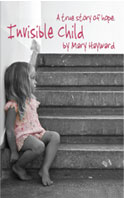Invisible Child

Click book to buy
This inspiring and uplifting true story shows how a damaged childhood can become an asset, in fighting back and winning against all odds. This compelling story is a tribute to all those brave women who believe in “yes we can”.
Mary’s life was always a miracle of survival. It is a tale of courage and responsibility, as she battles to keep herself and baby sister from starvation and TB, sometimes with fun and laughter, and at other times so desperate that we are drawn to tears. But when her best friend steals a rifle, we listen to her heartbreaking plea to the Samaritans as her life is crushed. It is a story of heartbreak and passion, a blinding love so certain that it comes but once in a lifetime. She finds her freedom to study at university, and doing what she does best, saving damaged children like herself.
The book starts with the death of my best friend Joyce. She shot herself in 1978, stealing a rifle and dying slowly in hospital weeks later. You can read that from the Amazon.co.uk free sample. But then the story flashes back to my life at the age of 8, and the harsh deprived beginnings, as it follows my journey through starvation, the teenage years of fun with Joyce and some of the madcap antics, rape, marriage and children, divorce, abuse, romance, happiness, success.
As one reader put it:-
Reviewed in the United States on 30 May 2019
Verified Purchase
Author Mary Hayward begins her memoir with a tragic event that shapes her life, then poignantly retraces her steps to her poverty-stricken and emotionally-needy childhood in the late 50s. She pulls at the reader’s heart. Though small in stature, Mary takes on the big role of caring for her alcoholic father, her sharp, bitter mother who seems unable to dole out much, if any, love, and a sibling, too young to understand.
Mary writes in an eloquent, almost lyrical style, at times when describing the few special moments that stand out in her childhood when she felt loved or cared for—swimming at a seaside school outing, being a flower girl for an auntie’s wedding in a dress that makes her feel like a princess. She brings in all the senses. But even these positive moments are tinged with despairing consequences—heart rendering moments.
Yet there is an indelible cord of strength that winds itself through the pages of this memoir. During the author’s deepest despair, it binds her to herself. Her great intellect makes up one strand, her courage, another, compassion draws the cord taut. But it is forgiveness that makes the thread invincible in the end.
Sometimes the characters she writes of seem almost too flawed, including herself. I long for something better, more uplifting. Just when I least expect it, she offers it, like a beautifully-wrapped gift, to herself and the reader. Those moments leap out, catch at my heart, and I celebrate with her.
I liked how she could draw me into the myriad of emotions and decisions she is unable to share with those around her as the actual events unfold. She locks them tightly away and denies herself that privilege due to the long-internalized threat of being taken into “care.” I feel privileged she trusts me-an unknown reader—with such personal feelings. It must be freeing to let them go after all these years.


